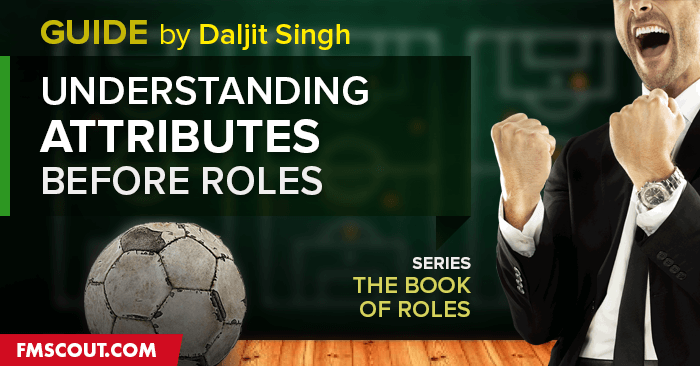
All Roles are a composite of attributes, each role has 36 attributes and some are more important than others. We need to list out some of the important attributes that need to be clearly understood before we delve into Player Roles.
Player attributes guide how well a player performs his core skills, this is perhaps one of the single biggest reasons why some managers struggle with the game.
Things can look good with a solid tactic, in fact most tactics will come out looking solid, until you do player selection. If you know what each role's key attributes are, then when things break down, it’s going to be easier for you to understand why.
This is a “micro-aspect” of the game that is central to making tactics work. By and large the Tactical Creator itself just aggregates all these player attributes when instructions are issued.
A solid tactic is easier to make than trying to identify which player is making the system fall apart. And for long term success with the game, understanding which attributes are vital.
Back in the day when the game was identified as CM instead of FM all we had to tell us what was happening was commentary mode, so all we did was pay attention to the commentary and then analyse that against the match statistics.
A typical analysis would begin with match ratings, then we would identify the player concerned who was generating poor numbers. We would then drill down to his in-game performance statistics.
If it was a playmaker we would be looking for pass completion rates, key passes made. If an anomaly emerged we would then try to see why his pass completion rate was too low. Why were his passes not hitting the mark?
Then we would look at his attributes, if his attributes suggested that he could play well in the position, we would start considering whether he had enough support.
Was he spending more time trying to win the ball, instead of trying to play the risky pass? Was he under too much pressure? Did he get enough support? Without knowing what they key attributes are for each role, it would be akin to looking for a needle in a haystack.
FM is a simulation game built on binary numbers, defined by simple logical conditionals. At its basic core, FM is just a numbers game. Stick better numbers in and you should win.
So if you can rule out attributes, then it's always going to be your tactic. This makes the understanding of attribute relationships very important.
It’s the single biggest reason why a lot of novice players struggle. They are jumping in to the exotic creation of tactics without considering the weight that attributes play in the game.
Since attributes play such a big part of the game, Sports Interactive introduced the Tactical Creator.
This allowed people to stop focusing on simply getting the perfect player for the role, and instead introduced a system that was built around choosing the right role and duty for the right player within a tactical system.
There are 36 attributes for players divided into Technical, Mental and Physical attributes. These improve over time, and depend on the quality of training, the time a player spends playing first team matches and the kind of training he gets.
Goalkeepers and outfield players have slightly different attributes. This page details what some attributes are and how they impact your players. I have excluded explaining the obvious ones, but gone into detail with some that are often misunderstood.
Before we begin, there is something we need to establish-Benchmarks. A player with 15 First Touch will be considered excellent in a top league, and a person with 15 playing in the lower leagues would be superhuman.
A good yardstick is to look at 9 being average in the lowest leagues and then adding 2 for each league you are promoted to.
It's tough finding the right players but with time and effort it's possible, and, sometimes you may need to prioritise.
Goalkeepers
Aerial Ability - affects how high a goalkeeper's hands can reach when he jumps. For outfield players this attribute is called Jumping Reach. The keeper's one refers to how high his hands reach, and the outfield players ones determine how high they can jump to head a ball.Command of Area - How good the keeper is at controlling his area . How well he does at claiming aerial balls depends on his Aerial Ability, Handling, Anticipation, Decisions and Positioning.
Eccentricity - How likely a keeper is at doing unexpected and risky actions. This is a negative attribute.
Handling - How good a keeper is at handling a ball after stopping it. Can he hold onto the ball after catching it?
Kicking - How far can he kick? His accuracy depends on Decisions, Technique, Teamwork and Vision.
Rushing Out - Along with Pace and Acceleration, this attribute will influence how well a keeper can leave his area to close down or come up to play as a sweeper keeper. If he has good ratings for Anticipation, First Touch, Composure and Decisions he may have the ability to be an effective Sweeper Keeper.
Tendency to Punch - How likely a keeper is to choose to punch a ball. A higher rating could put pressure on his defence if he fails to punch well. If a keeper has poor handling than this attribute can help him at least punch the ball when he can’t catch it.
Outfield Players
First Touch - This attribute is vital for a team that wants to keep the ball and distribute it under pressure. It's also a good attribute for attackers. A team that has players with good first touch can take control of the ball with one touch passing quickly and effectively. It is one of the key attributes that influence the effectiveness of tactics. It’s also a key attribute that’s needed if you want to play systems where you want to control possession. Creative players require first touch, it's almost mandatory to get the ball under control so it can be distributed. And for defensive support players it's of secondary importance, with Concentration being key.Technique - How well players can perform more challenging actions. These include volleys, taking control of difficult balls, making difficult challenges, using tricks and long cross field diagonal passes.
Aggression - Is a misunderstood attribute. This is a good attribute for defenders provided they have good tackling, anticipation, concentration and decisions. The chance that a player will commit a violent challenge is influenced by other attributes such as Dirtiness and Sportsmanship which are hidden attributes.
Anticipation - Is both a defensive and offensive attribute. Players with good anticipation, acceleration and off the ball, make good players for running into channels. It's also a good attribute to have for slower defenders who possess good positioning and need to be able to step into covering areas earlier.
Composure - How well does a player handle himself under pressure. When a player has composure and first touch he is able to take the ball down quickly. He can also control the ball under pressure so that it can be distributed to other players. This is important for playmakers and pivots who are expected to provide effective links during transitions.
Decisions - This attribute influences how well a player considers his options, and this in turn is also influenced by vision which allows the player to see more of the play on the pitch. A player with good passing, visions and decisions has they key attributes to be a good playmaker.
Teamwork - If you want a team to play as a unit then this attribute is key. A player with good teamwork is also likely to sacrifice personal glory for the sake of the time. When you find that your flanks are exposed, you need to look at Work Rate, Teamwork and Bravery to understand why the support player didn’t show up. Since FM19, it’s also indicative of how well a player is likely to follow tactical instructions, whilst working for and alongside his teammates.
Balance - This attribute influences how well a player can stay on his feet under pressure both on and off the ball. A player with great balance and dribbling speed can turn players around. Think of Diego Maradona and Paul Gascoigne. A player with good balance is more dangerous when he has good first touch.
Determination - It determines how likely a player is try to put in an effort when the side is a goal down. A team with low determination in key areas is likely to fold if they go a few goals down. It reflects the players commitment to wanting to succeed and do his very best on and off the pitch. This is the most important attribute in the game because it affects a player's personality, which in turn affects how he could develop and train, and finally, how he might perform in games.
Bravery - This attribute indicates how willing a player is to take a necessary action which may cause personal pain or injury. Lower bravery attributes are usually a sign that a player is likely to hold back helping someone if there is a chance he will get injured. Low natural fitness and low bravery are a double whammy. You want to avoid signing players with a combination of low ratings in both.
Concentration - This is an attribute that indicates how well a player is able to maintain his focus during a game. Players in key roles such as defensive midfielders, holding players and defenders require good ratings in concentration. If they lose focus during a game, there is a chance that they will not see a danger developing until it's too late. Since FM19, they changed the description to indicate how well he could pay attention on an event by event basis. It has now been confirmed that this attribute affects all outfield players and can be very important factor whenever a team's transitions break down.
Flair - This attribute deals with the extraordinary that a player performs and covers actions like tricks and feints for example. These are unexpected actions that a player is likely to perform that catch the opposition unaware. It's a good attribute to have for a certain creative roles in a game, for e.g. Trequartista.
Off The Ball - This attribute describes how well a player moves and positions himself, to either provide a passing option or create space for others to exploit, when he is off the ball. It is probably one of the biggest attributes needed for fluid systems. For a fluid system to operate well, players need to be able to move in and out of passing triangles, and into other triangles. Coupled with the player preferred move “one-two passes” this attribute contributes to players moving into positions and offering themselves up as passing outlets.
Positioning - This attribute describes how well a players moves and positions himself defensively off the ball to handle opposition attacks when his side doesn’t have possession of the ball. Any player assigned a Defend duty will require good positioning, however if you don’t have players with good positioning, you will need players to have acceleration, concentration to get back to position. If they are slow they will need concentration, anticipation and positioning. In FM19 this attribute was also renamed so that it could reflect the ability of a player in reading situations and putting themselves into the best possible location to deal with unfolding events. Since off the ball refers to movement when you have the ball and are in possession of it, this still seems to be the defensive version of that attribute.
Vision - This attribute lets us know how well a player sees the actions available to him. A player with higher rating is able to assess from a wider array of possible scenarios. Decisions indicate how well he processes those observations.
Pace - How fast a player can run after he has achieved maximum speed, it his constant maximum velocity. If you are trying to develop a counter attacking system that’s deep then you will need some of your players to be blessed with pace, acceleration, first touch, balance and dribbling
Acceleration - Is how quickly a player can reach his maximum velocity. If you want to beat players on the turn then you need acceleration. Once you have beaten the player and are heading to goal, then you need pace to keep that maximum speed going. If you are using a fluid system and you need your players to beat tight marking, then acceleration, off the ball, first touch, balance and dribbling are going to be important.
Natural Fitness - This attribute proves important for managing older players. It reflects how well a player stays fit when injured or not in training. It also indicates how well they can maintain their physical attributes past their peak and maintain their fitness between matches.
Hidden Attributes
There are six hidden attributes, and when you assign your scouts to evaluate a player, their reports give you an indication of what these are:Adaptability - How well a player settles down after a transfer. A player with low adaptability may have issues playing for another team in another country. For scouts and coaches, it affects how easily they handle assignments when they move to a new country.
Consistency - This attribute affects physical and mental attributes. Players with good physical attributes are less likely to be affected by consistency
Dirtiness - Players with high ratings in this attribute are likely to bend the rules in a match. If the scout report states that a player has a competitive streak in him, then he has a high rating in Dirtiness and is likely to commit more fouls
Important Matches - How well a player rises to the occasion. A player with low ratings is likely to feel the pressure in big matches.
Injury Proneness - How likely a player is to pick up injuries, if a player has low natural fitness and injury proneness it's double jeopardy.
Versatility - Influences how well a player takes to a position he is not familiar with. This influences how well he can learn new positions. This acts as a kind of limiting factor to the amount of positions a player can master and how well he masters them.
Understanding Player Roles
Whenever people struggle with the game, the reason why this happens is simple, and it usually boils down to a pre-conceived bias. They expect to see roles and instructions behave according to their bias.The issue with this is that it's probably not in line with how SI have designed roles, duties, team and player instructions.
I feel that understanding how different roles move around the pitch will give you a better understanding of one of the most important concepts in football - Controlling Space.
When creating tactics we need to know how we are going to win games with the players at our disposal. Visualising how we score goals helps.
You need to pick your battles carefully on the pitch, choosing which ones to win and which ones you can afford to lose.
There are many ways to build a tactic, you can go ground up by analysing your team to find a tactical shape that suits them or you can impose your own tactical shape on them and slowly mould them into how you want to play. There is no right way, only your way.
Ultimately football is just a battle on a pitch where sides try to win battles across the pitch.
Weaker sides will try and win the battles in defence and try and launch quick counters. Sometimes they will try and force stronger sides on the backfoot and deny them a chance to play their game.
Stronger sides could try and impose their will on a game and try and control the bigger areas of the pitch forcing weaker sides into an endless barrage of attacks.
That’s the beauty of the game – there is no one tactical approach, and that’s the same with creating a tactical system. There are many ways to do it.
There is one thing that stands true in any system. You need to find the right player to do the job you want.
If you aim to play a defensive game then you need the right kind of players to do the job. Choosing the right player for the right task is also just as important.
A role can be played in different ways and it can work in combination with other instructions in the game to offer you choices. How these roles play on the pitch can affect your tactical shape, so it's important to understand the basics first.
Once you understand roles you will be able to make effective combinations with the players that you have.
The mistake nearly everyone makes is failing to understand what a role does and how a role moves around the pitch. This isn’t made any easier by SI who leave users to glean this information themselves.
While some may say it's vital to choose the right player for the right role, what’s more important is understanding how roles are meant to perform.
You can try any role with any player in the game, naturally some perform better at it, and this could be down to how they combine with other players.
This is why it's important to know what they are capable of doing.





![FM26 Data Tweaks [v1.1 | v1.8]](assets/downloads/fm26/fm26-data-tweaks-by-sirtavares-v2.th.png)


![TinyHips' Dark Mode Skin v5.3 [Win + MacOS] *UPDATED 26.1.1 HOTFIX*](assets/downloads/fm26/fm26-dark-mode-skin.th.png)

Discussion: Understanding Player Attributes Before Roles
No comments have been posted yet..